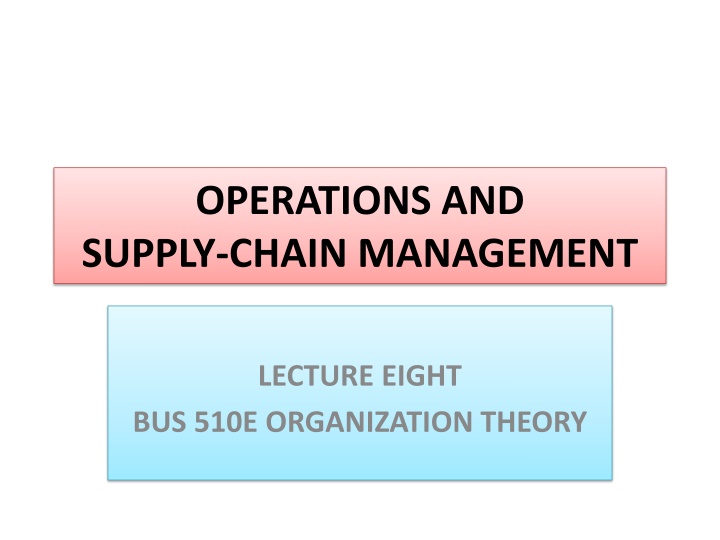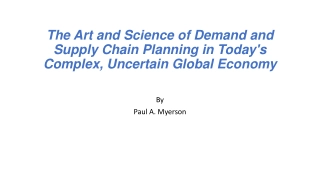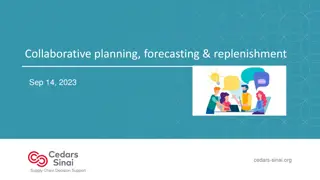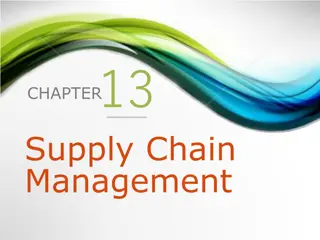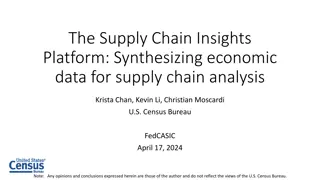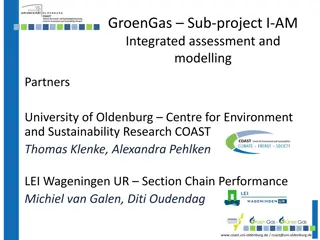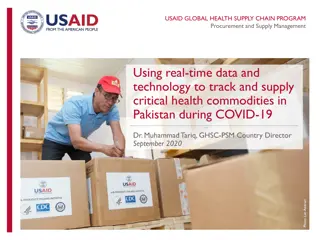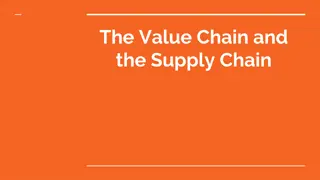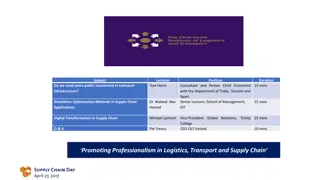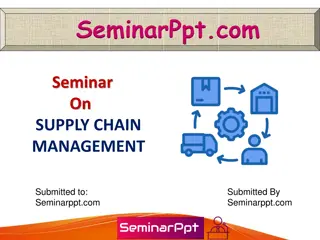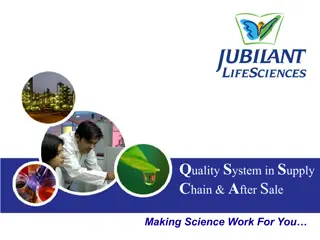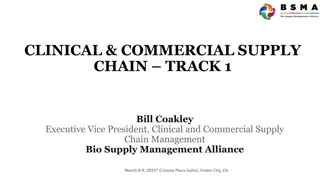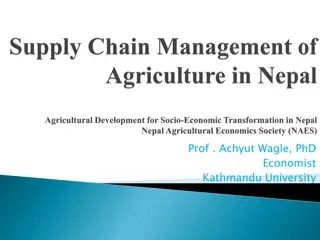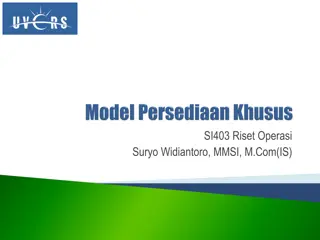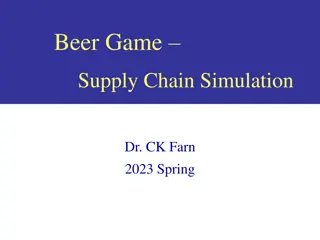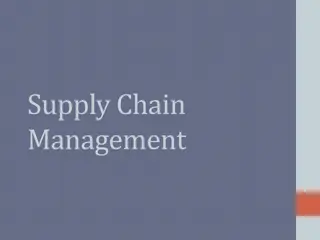Operations & Supply-Chain Management Lecture: Organization Theory
Operations and Supply-Chain Management (OSCM) involves the design, operation, and improvement of systems that create and deliver a firm's primary products and services. It includes processes such as planning, sourcing, making, delivering, and returning, each critical for strategic supply chain management. Planning ensures efficient resource allocation, sourcing focuses on supplier selection and relationship management, making involves production coordination, delivering pertains to logistics and warehousing, and returning deals with product returns and defects.
Download Presentation

Please find below an Image/Link to download the presentation.
The content on the website is provided AS IS for your information and personal use only. It may not be sold, licensed, or shared on other websites without obtaining consent from the author.If you encounter any issues during the download, it is possible that the publisher has removed the file from their server.
You are allowed to download the files provided on this website for personal or commercial use, subject to the condition that they are used lawfully. All files are the property of their respective owners.
The content on the website is provided AS IS for your information and personal use only. It may not be sold, licensed, or shared on other websites without obtaining consent from the author.
E N D
Presentation Transcript
OPERATIONS AND SUPPLY-CHAIN MANAGEMENT LECTURE EIGHT BUS 510E ORGANIZATION THEORY
OPERATION & SUPPLY CHAIN MANAGEMENT (OSCM) OSCM is defined as the design, operation, and improvement of the systems that create and deliver the firm's primary products and services.
Operations and Supply-Chain Processes Planning Sourcing Making Delivering Returning
PLANNING OF OSC PROCESSES Planning consists of the processes needed to operate an existing supply chain strategically. Here a firm must determine how anticipated demand will be met with available resources. A major aspect of planning is developing a set of metrics to monitor the supply chain so that it is efficient and delivers high quality and value to customers.
SOURCING OF OSC PROCESSES Sourcing involves the selection of suppliers that will deliver the goods and services needed to create the firm's product. A set of pricing, delivery, and payment processes is needed together with metrics for monitoring and improving the relationships between partners of the firm.
MAKING OF OSC PROCESSES Making is where the major product is produced or the service provided. The step requires scheduling processes for workers and the coordination of material and other critical resources such as equipment to support producing or providing the service.
DELIVERING OF OSC PROCESSES Delivering is also referred to as logistics processes. Carriers are picked to move products to warehouses and customers, coordinate and schedule the movement of goods and information through the supply network, develop and operate a network of warehouses, and run the information systems managing the receipt of orders, and invoicing systems to collect payments from customers.
RETURNING OF OSC PROCESSES Returning involves the processes for receiving worn-out, defective, and excess products back from customers and support for customers who have problems with delivered products. In the case of services, this may involve all types of follow-up activities that are required for after-sales support.
A SUSTAINABILITY STRATEGY THREE CONSTRAINTS 1. Social: Pertains to fair and beneficial business practices toward labor, the community, and the region in which a firm conducts its business. A triple bottom line company seeks to benefit its employees, the community, and other social entities that are impacted by the firm's existence. 2. Economic: The firm is obligated to compensate shareholders who provide capital through stock purchases and other financial instruments via a competitive return on investment. Company strategies should promote growth and grow long-term value to this group in the form of profit. 3. Environmental: This refers to the firm's impact on the environment. The company should protect the environment as much as possible - or at least cause no harm. Managers should move to reduce a company's ecological footprint by carefully managing its consumption of natural resources and by reducing waste, and ensuring that the waste is less toxic before disposing of it in a safe/legal manner.
The Product Development Process 0 Planning 5. Production Ramp-up 1. Concept Development 4. Testing and Refinement 2. System-level Design 3. Detail Design
THE PRODUCT DEVELOPMENT PROCESS Phase 0 to 5 Design Manufacturing Marketing Phase 0 Planning *Consider product platform and architecture *Assess new technologies *Identify production constraints *Set supply chain strategy *Articulate market opportunity *Define market segments *Investigate feasibility of product concepts *Develop industrial design concepts *Build and test experimental prototypes *Estimate manufacturing cost *Assess production feasibility *Collect customer needs *Identify lead users *Identify competitive products Phase 1 Concept Development Phase 2 *Generate alternative product architectures *Define major subsystems and interfaces *Refine industrial design *Identify suppliers for key components *Perform make-buy analysis *Define final assembly scheme *Set target costs *Develop plan for product options and extended product family *Set target sales price point(s) System-level Design
THE PRODUCT DEVELOPMENT PROCESS Phase 0 to 5 Design Manufacturing Marketing *Define part geometry *Choose materials *Assign tolerances *Complete industrial design control documentation Define piece-part production processes *Design tooling *Define quality assurance processes *Begin procurement of long-lead tooling *Develop marketing plan Phase 3 Detail Design *Reliability testing *Life testing *Performance testing *Obtain regulatory approvals *Implement design changes *Facilitate supplier ramp- up *Refine fabrication and assembly processes *Train workforce *Refine quality assurance processes *Develop promotion and launch materials *Facilitate field testing Phase 4 Testing and Refinement Phase 5 *Evaluate early production output *Begin operation of entire production system *Place early production with key consumers Production Ramp-up
BREAK TIME 5 MINUTES TAKE FRESH AIR OUTSIDE
The Layouts of the Production Process 1. Project Layout 2. Work-centers 3. Manufacturing Cell 4. Assembly Line 5. Continuous Process
THE LAYOUTS OF THE PRODUCTION PROCESS 1. Project Layout: The product remains in a fixed location. Manuf. equipment is moved to the product rather than vice versa. 2. Work-centers: It refers to as a job shop, is where similar equipment or functions are grouped together, such as all drilling machines in one area and all stamping machines in another. A part being worked on travels, according to the established sequence of operations, from work center to work center. 3. Manufacturing cell: It is a dedicated area where products that are similar in processing requirements are produced. These sells are designed to perform a specific set of processes, and the cells are dedicated to a limited range of products. A firm may have many different cells in a production area, each set up to produce a single product or a similar group of products efficiently. 4. Assembly Line: It is where work processes are arranged according to the progressive steps by which the product is made. The path for each part is, in effect, a straight line. Discrete products are made by moving from workstation to workstation at a controlled rate, following the sequence needed to build the product. 5. Continuous process: It is similar to an assembly line in that production follows a pre-determined sequence of steps, but the flow is continuous such as with liquids, rather than discrete. Such structures are usually
CONTEMPORARY APPLICATION 1. The Digital Factory - Computer-integrated manufacturing: Digital factories link manufacturing components that previously stood alone: robots, machines, product design, and engineering analysis are coordinated by a single computer system. The digital factory is typically the result of subcomponents such as computer-aided design, computer- aided manufacturing, manufacturing process management, integrated information network, and product life-cycle management. 2. Lean Manufacturing uses highly trained employees at every stage of the production process, who take a painstaking approach to details and problem solving to cut waste and improve quality. Lean manufacturing incorporate technological elements, but heart of lean manufacturing is not machines or software, but people - essentially centered on preserving value with less work. Lean manufacturing requires changes in organizational systems, such as decision-making processes and management processes, as well as an organizational culture supporting active employee participation, a quality perspective, and focus on the customers. Employees are trained to attack waste and strive for continuous improvement in all areas.
Manufacturing Technologies 1. Tangible product 2. Products can be inventoried for later consumption 3. Capital asset-intensive 4. Little direct customer interaction 5. Human element may be less important 6. Quality is directly measured 7. Longer response time is acceptable 8. Site of facility is moderately important
Service Technologies 1. Intangible output 2. Production & consumption take place simultaneously 3. Labor- and Knowledge-intensive 4. Customer interaction generally high 5. Human element very important 6. Quality is perceived and difficult to measure 7. Rapid response time is usually necessary 8. Site of facility is extremely important
Structural Characteristics Service vs Product Organization Characteristics Service Product Structural Characteristics 1. Separate boundary roles 2. Geographic dispersion 3. Decision Making 4. Formalization Few Much Many Little Centralized Higher Decentralized Lower Human Resources 1. Employee skill level 2. Skill emphasis Higher Lower Technical Interpersonal
Job Design 1. Job design includes the assignment of goals and tasks to be accomplished by employees. Managers may consciously change job design to improve productivity or worker motivation. However, managers may also unconsciously influence job design through the introduction of new technologies, which can change who jobs are done and the very nature of jobs. Managers should understand how the introduction of a new technology may affect employees' jobs. The common theme of new technologies in the workplace is that they in some way substitute machinery for human labor in transforming inputs into outputs. 2. In addition to replacing human workers, technology may have several different effects on the human jobs that remain. Mass-production technologies tend to produce job simplification, which means that the variety and difficulty of tasks performed by a single person are reduced, and boring and repetitive jobs provide little satisfaction. Hence, managers introduced job rotation and job enrichment. On the other hand, digital manufacturing and other advanced technology may contribute to job enlargement, which is an expansion of the number of different tasks performed by an employee.
SOCIO-TECHNICAL SYSTEM MODEL The Social System The Technical System Design for Joint Optimization Work roles, tasks, Work flow Goals and values Skills and abilities *Individual and team behaviors *Organizational/team culture *Management practices *Leadership style *Degree of communication openness *Individual needs and desires *Type of production technology *Level of interdependence *Physical work setting *Complexity of production process *Nature of raw materials *Time pressure
STRATEGIC SOURCING A. Strategic sourcing is the development and management of global supplier relationship to acquire goods and services in a way that aids in achieving the immediate needs of the business. B. Outsourcing is the act of moving some of a firm's internal activities and decision responsibility to outside providers. Outsourcing goes beyond the more common purchasing and consulting contracts because not only are the activities transferred, but resources that make the activities occur, including people, facilities, equipment, technology, and other assets, are also transferred. C. Green Sourcing is to revamp their procurement policies to be more sustainable and efficient by finding new environmentally friendly technologies or increasing the use of recyclable materials.
GREENING SOURCING 1. Assess the opportunity 2. Engage internal supply chain sourcing agents 3. Assess the supply base 4. Develop the sourcing strategy 5. Implement the sourcing strategy 6. Institutionalize the sourcing strategy
LOGISTIC SYSTEM DESIGN Definition of Cross-Docking Cross-docking is a practice in logistics of unloading materials from an incoming semi- trailer truck or railroad car and loading these materials directly into outbound trucks, trailers, or rail cars, with little or no storage in between. This may be done to change type of conveyance, to sort material intended for different destinations, or to combine material from different origins into transport vehicles with the same, or similar destination.
LOGISTGIC SYSTEM DESING Advantages of Retail Cross-Docking Streamlines the supply chain from point of origin to point of sale Reduces handling costs, operating costs, and the storage of inventory Products get to the distributor and consequently to the customer faster Reduces, or eliminates warehousing costs May increase available retail sales space.
Sales and Operations Planning Sales and operations planning is a process that helps firms provide better customer service, lower inventory, shorten customer lead times, stabilize production rates, and make top management do the business. The Aggregate Operations Plan is concerned with setting production rate by product group or other broad categories for the intermediate term (3 to 18 months). The main purpose of the aggregate plan is to specify the optional combination of production rate, workforce level, and inventory on hand. Yield Management can be defined as the process of allocating the right type of capacity to the right type of customers at the right price and time to maximize revenue or yield. Inventory Systems: An inventory system provides the organizational structure and the operating policies for maintaining and controlling goods to be stocked.
Master Production Scheduling All production systems have limited capacity and limited resources. This presents a challenging job of the master scheduler. Although the aggregate plan provides the general range of operation, the master schedule must specify exactly what is to be produced. These decisions are made while responding to pressures from various functional areas such as the sales department (meet the customer's due date), finance (minimize inventory), management (maximize productivity and customer service, minimize resource needs), manufacturing (have level schedules and minimize setup time).
MASTER PRODUCTION SCHEDULING All production systems have limited capacity and limited resources. This presents a challenging job of the master scheduler. Although the aggregate plan provides the general range of operation, the master schedule must specify exactly what is to be produced. These decisions are made while responding to pressures from various functional areas such as the sales department (meet the customer's due date), finance (minimize inventory), management (maximize productivity and customer service, minimize resource needs), manufacturing (have level schedules and minimize setup time).
Manufacturing Execution Systems A manufacturing execution system is an information system that links schedules, dispatches, tracks, monitors, and controls the customer's encounters with the service organization and its employees. The common features are a central database that contains all the relevant information on resource availability and customers and a management control function that integrates and oversees the process.
END OF THE LECTURE SEE YOU NEXT WEEK
